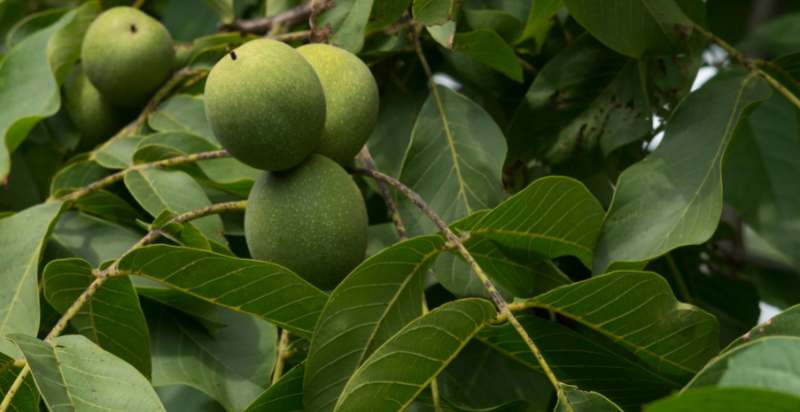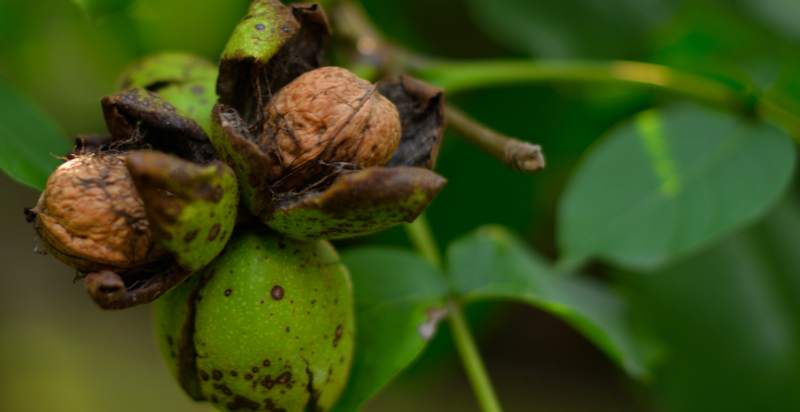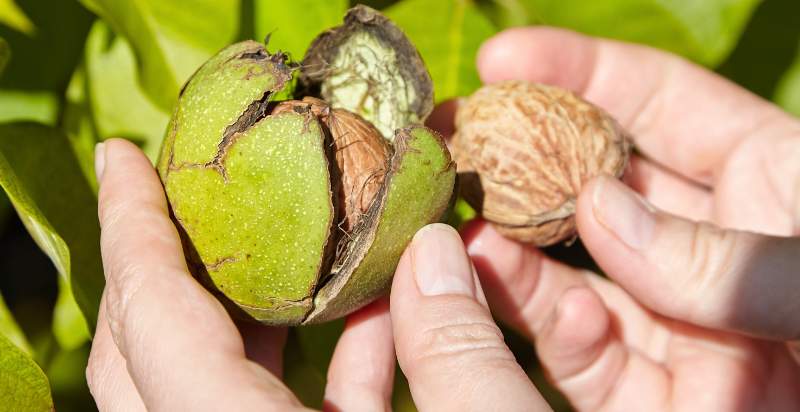The walnut is a type of tree nut and one of the most popular nuts in the world. It is highly nutritious, packed with essential vitamins and minerals, and has many health benefits. Walnuts are believed to have originated in Central Asia and have been eaten for thousands of years by people all over the world. They are an excellent source of protein, dietary fiber, healthy fats, antioxidants, minerals, and vitamins. Here’s everything you need to know about walnuts and how they can benefit your health.
What is Walnut?
Walnuts are the edible seeds of a deciduous tree native to Central Asia and Europe. The walnut tree is an evergreen with glossy leaves and yellow-brown bark. It takes up to 20 years for the trees to fully mature and bear fruit. The walnut fruits consist of two halves containing one or two individual nuts. They have a hard, ridged shell with a brownish-gray color. Inside is a white kernel that contains the edible part of the nut.
History and Origin of Walnuts:
Walnuts have a long and illustrious history that dates back thousands of years. Historians believe walnuts were one of the earliest domesticated food crops, with evidence indicating that they were cultivated in Europe as early as 3000 BC. The ancient Greeks and Romans both enjoyed eating walnuts, and nuts became a popular ingredient in many recipes from these cultures. Walnuts also played an important role in Ancient Chinese medicine, treating various ailments such as headaches, fever, constipation, and skin diseases.
Walnuts are native to Central Asia, but they spread throughout much of Europe during Renaissance times thanks to traders, merchants, and explorers who brought them over from all corners of the world. Walnut trees began appearing in North America during the 16th century when Spanish explorers brought them to Mexico. From here, they spread throughout the continent and were widely cultivated by Native American tribes, who used them as a source of food and medicine.
Today, walnuts are enjoyed worldwide and can be found in many different forms, including oil, flour, butter, and paste. They are also often eaten raw or added to salads, desserts, cereals, and other recipes for a nutritional boost. Walnuts are an excellent source of plant-based protein and healthy fats that have been linked with numerous health benefits. This makes them an important part of any balanced diet.
Types of Walnuts:
Walnuts come in a variety of shapes, sizes, and colors. Common walnuts include English Walnuts (also known as Persian or Carpathian walnuts), Black Walnuts, Japanese Walnuts, and Butternuts.
English Walnuts have a smooth, light-brown shell, and the nut inside is encased in a thick, cream-colored husk. The kernels are creamy-white with a sweet flavor and can be used for baking or snacking.
Black Walnuts have an extremely hard shell which makes them difficult to crack open, but their intense flavor makes it worth the effort. Inside are dark-brown kernels that are full of flavor and aroma. These nuts are popular in pies, cookies, and other baked goods.
Japanese Walnuts have a thin, dark-brown shell that’s easy to crack open. Inside you’ll find large kernels with a mild, sweet flavor. They are commonly used in Chinese dishes such as stir-fries and desserts.
Butternuts are not true walnuts, but they look similar and taste similar. They have an oblong shape with a smooth, yellow-brown shell, and the kernel inside is cream-colored. Butternuts can be eaten raw or roasted for use in baking or salads.
No matter which type of walnut you choose, they are a great source of protein, healthy fats, vitamins, and minerals. They make a tasty snack or addition to your favorite recipes. With so many different types available, it’s easy to find one that suits your tastes.
Nutritional Value of Walnuts:
Walnuts are an excellent source of nutrients and have many health benefits. They are a good source of protein, fiber, vitamins, and minerals such as magnesium, potassium, calcium, and zinc. Walnuts contain healthy fats known as omega-3 fatty acids, which help protect the heart from disease. They also contain antioxidants which can help reduce inflammation in the body. Furthermore, walnuts are also rich in phytosterols which may help to lower cholesterol levels in the blood. All these nutritional benefits make walnuts a great addition to any diet for overall health and well-being.
Health Benefits of Walnuts:
Walnuts are incredibly nutritious nuts that offer a variety of health benefits. They contain beneficial nutrients, including quality protein, healthy fats, antioxidants, vitamins, and minerals. Some potential health benefits of walnuts include improved heart health, better brain function, and protection against certain types of cancer.
- Heart Health: Walnuts contain high omega-3 fatty acids, which are associated with improved heart health and reduced risk of cardiovascular disease. Research suggests that incorporating walnuts into your diet can increase good cholesterol (HDL) levels and reduce bad cholesterol (LDL). Eating walnuts may also help lower blood pressure.
- Brain Function: Walnuts are rich in antioxidants which help protect the brain from oxidative stress and inflammation. They also contain plant-based omega-3 fatty acids necessary for normal brain functioning. Eating walnuts may help boost memory and improve concentration.
- Cancer Prevention: Walnuts are high in antioxidants which can protect against free radical damage that can lead to cancer development. Studies suggest that walnut consumption may reduce the risk of certain cancers, such as colorectal cancer, prostate cancer, and breast cancer.
Overall, it is clear that walnuts are an excellent source of nutrition with numerous potential health benefits. They provide a great balance of protein, fiber, vitamins and minerals, healthy fats, and antioxidants. Eating a handful of walnuts each day can help to improve overall health and well-being in many ways. Walnuts make an excellent snack or addition to any meal, so why not start adding them to your diet today.
What are the Uses of Walnuts?
Walnuts are incredibly versatile and nutritious, making them a great addition to any diet. They are a rich source of healthy fats, protein, essential vitamins, minerals, and plenty of antioxidants. Walnuts may help reduce inflammation, lower cholesterol levels, improve heart health and brain function, and even aid in weight loss efforts. Walnuts can also be used as an easy snack or added to salads, oatmeal, or yogurt for extra flavor and crunch.
Roasted walnuts make a great topping for ice cream sundaes or blended into smoothies. Walnuts can be incorporated into various recipes, such as chia seed pudding, pesto sauce, or homemade energy bars.
As the uses suggest, there are many possibilities when incorporating walnuts into your meals and snacks. So go ahead and start adding more walnuts to your diet today. Your body will thank you!
How to Plant Walnuts?
Walnuts are a versatile nut crop that can be grown in both temperate and subtropical regions. Walnuts, scientifically known as Juglans regia, are one of the most popular nuts consumed worldwide due to their distinct flavor and high nutritional value. Walnut trees can produce up to 500 pounds of walnuts per tree per year and have an average lifespan of 40-50 years! Planting walnuts is quite simple and easy for any gardener.
Soil Preparation:
Before planting your walnut tree, it’s important to prepare the soil properly. The best soil for planting walnuts should have adequate drainage with a slightly acidic pH between 5.5 – 6.2, depending on the variety of walnut trees you are planting. The soil should also be well-aerated, as walnut trees require good air circulation for optimal growth.
Planting the Walnuts:
Once you have prepared the soil and chosen a suitable location, it’s time to plant your walnut tree. Planting is done in early spring when temperatures start warming up, with seedlings or nutlets being planted at least 10 feet apart. When planting from seedlings or nutlets, ensure the root ball is kept moist throughout the process to prevent any damage to the roots before they can take hold in the new soil.
Post-Planting Care:
After your walnut trees are planted, you can do a few things to ensure that they are healthy and able to thrive. The soil around the tree should be kept moist until established. Additionally, applying an all-purpose fertilizer once or twice during the first year of growth will help your walnut tree develop strong roots faster. Finally, pruning may be necessary to shape the canopy and promote better air circulation, depending on the type of walnut tree. Your walnut trees can give you years of delicious harvests with proper care and attention!
By following these simple steps on how to plant walnuts and taking good care of them afterward, you’ll soon have a flourishing walnut tree producing plenty of food for years to come. Whether you’re looking for a tasty snack or want to add shade and greenery to your yard, planting walnuts is an excellent choice!
With the right preparation, care, and attention, your walnut trees will produce plenty of delicious walnuts in no time.
How to Care for and Grow Walnuts?
Walnuts are a wonderful nut to have around the home as they can be used in many different recipes, from desserts to main dishes. To ensure that your walnut trees stay healthy, remember a few key points when caring for them.
To begin with, giving walnut trees lots of sun and water is important. Walnut trees need at least 8 hours of full sunlight each day and should be watered deeply every 7-10 days during summer. During winter months, water deeply once or twice per month, depending on how wet the soil is. Additionally, mulching around the tree will help conserve moisture and control weeds.
When fertilizing walnut tree, starting with a slow-release fertilizer in the early spring is best, followed by another application in late summer. Ensure not to fertilize too heavily, as this can cause leaf burn.
Finally, pruning is important in caring for and growing walnut trees. Prune your walnut tree at least once every two years to remove any dead or unhealthy branches and promote better growth. Additionally, remove any competing vegetation, so your walnut tree has enough room to grow properly.
With proper care and attention, your walnut tree will be able to thrive and provide you with delicious nuts for many years!

Preventions from Pests and Diseases of Walnuts:
Preventing pests and diseases of walnuts starts with selecting disease-resistant varieties. Good preventive maintenance includes the following:
- Regularly inspect for signs of pest damage or fungal infection; promptly remove infected limbs, twigs, and nuts, as well as any fallen leaves and debris that may be harboring insects.
- Avoid cultivating the soil around trees, which can bring pests to the surface where they can attack plants more easily.
- Maintain a 3-4 foot buffer zone between trees to reduce competition for light, nutrients, and water. Prune off dead branches or suckers in late winter before the sap flows.
- Fertilize walnuts carefully according to soil test results; too much nitrogen can encourage soft growth, which is more susceptible to attack by insects and pathogens.
- Mulch around trees but not directly against the trunk. This helps conserve moisture and smother weed growth that might harbor pests or disease vectors.
- Water trees deeply, directing water at the soil rather than on foliage to avoid encouraging fungal diseases.
- Use organic methods such as beneficial nematodes or insecticidal soaps when possible, instead of harsh chemical pesticides and herbicides; apply these in late summer before the onset of wet weather conducive to disease spread.
- Keep records of pest activity; use this information to plan future preventive measures and determine whether additional control steps are necessary.
- Monitor weather conditions and take advantage of temporary temperature or humidity fluctuations to reduce pest populations.
By following these tips, you can help protect your walnut trees from the ravages of pests and diseases and ensure a healthy harvest for years to come.

How to Harvest Walnuts?
Harvesting walnuts is a rewarding process, but it takes patience and care. The most important thing to remember is that walnuts must be harvested at the right time for the best flavor and longest shelf life. Here are some tips for harvesting your walnuts:
- Look for signs of ripeness: Walnut hulls should be slightly soft when ripe, with a slight yellowish-green hue. Check your trees regularly to make sure they’re not overripe or underripe.
- Timing is key: Depending on where you live, the best harvesting time usually ranges from late summer to early fall. If you’re in doubt, consult with local experts such as agricultural extension agents.
- Gather the hulls: When walnuts are ripe, shake or beat the tree to dislodge them from the branches. Wear work gloves while gathering and sorting them to avoid injury.
- Clean and dry: Once you’ve gathered your walnuts, clean off any remaining husk material with a soft cloth before drying them in a cool, dry place. This can take up to three weeks, depending on humidity levels.
- Store properly: Walnuts will keep for several months if stored in a cool, dark place like an air-tight container or sealed bag with silica gel packets. Don’t forget to label each batch with the harvest date, so you know when to consume or discard.
Harvesting walnuts can be a fun way to get fresh, high-quality nuts for cooking and baking. With the right technique and patience, you’ll have a delicious crop in no time!

How to Store Homegrown Walnuts?
Once you have harvested your homegrown walnuts, it is important to store them to ensure they stay fresh properly. Walnuts can be stored in a cool and dry place for up to 6 months. Please do not wash the walnuts before storing them, as this will reduce the shelf-life of the nuts.
To preserve their flavor and crunchiness, store walnuts in an airtight container or tightly sealed bag in a refrigerator or other cold storage area. To stop them from becoming rancid due to oxidation, add a few drops of food-grade anti-oxidant oil such as lemon juice over the top of the nuts before sealing the container.
If you don’t plan on eating all your walnuts at once, you can store them in a freezer-safe container or zip-lock bag for up to two years. It is important to make sure the walnuts are completely dry before freezing them as moisture will cause them to become soggy when thawed.
In addition, walnuts should be stored away from sunlight and other sources of heat that could cause the nuts to spoil. When storing soaking walnuts (soaked overnight), add fresh water daily and refrigerate them in an airtight container for 3-5 days. This will help maintain the freshness and flavor of your homegrown walnut crop!
Finally, always check on the quality of your stored walnuts before using them; discard any that have become mushy, discolored, or have an off-odor. You can enjoy the delicious taste of your homegrown walnuts with proper storage for months!

How to Use Walnut in your day-to-day life?
Walnuts are incredibly versatile nuts that can be used in various ways. From toppings on salads and oatmeal to tasty sides for dinner, these crunchy nuts provide a unique flavor and texture sure to please everyone.
For breakfast, walnuts make a great addition to yogurt or oatmeal. Add chopped walnuts with fresh fruit for a delicious topping, or sprinkle them over pancakes before flipping. Walnuts also work well in smoothies; try blending up some vanilla Greek yogurt with frozen banana slices, walnuts, and a bit of almond milk for a delicious morning treat!
You can use walnuts as part of your main course or as a side dish when making lunch or dinner. Add chopped walnuts to a spinach salad for crunch, or mix them into your favorite pasta dish. You can also try roasting walnuts with olive oil and seasonings for a tasty side dish that goes great with any meal.
If you’re looking for a healthier option, try baking with walnuts instead of butter or oil. They make an excellent substitute for baked goods such as muffins, cookies, and bread. For something sweet, pair chopped walnuts with dark chocolate chips in your favorite dessert recipes to add even more flavor and texture!
No matter how you use them, walnuts are sure to bring unique flavor and texture to any dish! Enjoy them as part of your day-to-day life for a delicious and nutritious addition to your meals.

Potential Risks from Walnut in your day-to-day life:
Eating too many walnuts can lead to certain health risks. Eating large amounts of walnuts can increase the risk of weight gain, diabetes, and heart disease due to their high fat and calorie content. Walnuts also contain phytic acid, which is an antioxidant that can interfere with the absorption of some minerals such as zinc and iron. High levels of phytic acid-containing foods could lead to mineral deficiencies. Additionally, people allergic to tree nuts should avoid eating walnuts as they may cause an allergic reaction. Talking to a doctor before adding large amounts of walnuts into your diet is important.
Lastly, the thin shell on walnut halves can be a choking hazard for small children or those with difficulty swallowing. It is best to supervise children eating walnuts and avoid giving them to young toddlers. All in all, it’s important to monitor the number of walnuts eaten in a day-to-day diet as consuming large amounts can pose health risks. Additionally, it may be beneficial to talk with a doctor before including significant amounts of walnuts into your diet. Finally, make sure that small children are adequately supervised when eating walnuts.
Conclusion:
Walnuts are delicious and nutritious nuts that can be used in a variety of different dishes. Whether topping off a salad or baking some muffins, walnuts bring unique flavor and texture to any dish. However, eating too many walnuts can lead to certain health risks such as weight gain, diabetes, and heart disease due to their high fat and calorie content.
Additionally, small children should always be supervised when eating them because the thin shell on walnut halves is a choking hazard. Therefore, it’s important to monitor the number of walnuts eaten in a day-to-day diet and talk with a doctor beforehand if significant amounts will be included in your diet. With proper use of walnuts in moderation, you can enjoy all their delicious benefits for a nutritious and tasty part of your day-to-day life.
- Water Berries: Description, Flavor, Benefits, And Uses - June 18, 2024
- Everything You Wanted To Know About Sweetheart Cherries - June 17, 2024
- Indian Jujube: Description, Flavor, Benefits, And Uses - April 30, 2024

4 thoughts on “What is Walnut? How to Plant, Grow, and Harvest Walnuts ”
Comments are closed.